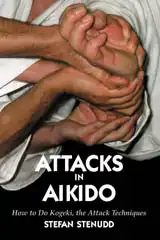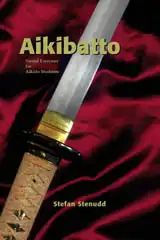TenchinageThe aikido technique tenchinage, heaven-earth throw, against different attacks
Tenchinage is one of the basic throws in aikido, exercised a lot in many dojos. The most common application is on the attack ryotedori, when both wrists are grabbed, but the throw can be done against just about any attack. I mostly show tenchinage rather slowly for clarity, usually gotai (from a static starting point). But there is also some jutai (moving as the attack approaches). In most cases, there is little difference between gotai and jutai versions of tenchinage, except the timing.
Heaven-earth throwTenchinage means “heaven-earth throw,” which refers to the arm movements in the technique — one arm goes up and the other goes down. At the end of the throw the arms tend to move towards the middle, behind the attacker.The arm that goes down gets the attacker out of balance, while the arm that goes up completes the throw in a manner similar to that in iriminage. But the extension of the lower arm is also instrumental in the throw. It is even possible to do the throw with just the lower arm, although that is not recommendable. Using both arms makes the technique more reliable. Tenchinage is a popular technique among aikido practitioners. There is a swiftness to it, and it can be done rather fast. It's not uncommon to do the throw so that it leads to a high forward fall (mae ukemi), but mostly I prefer to make it a backward fall (ushiro ukemi). It increases control of the attacker, and the throw can be adapted to the attacker's falling skills.
Strikes vs. grabsWhen the attack is a strike, there is no gotai version (from a static position). You need to initiate before the attack reaches, which is jutai. The timing must be such that you grab and lead the attacking arm before the attack is completed and the attacker stops. Otherwise, you may miss it if the arm is pulled back for a new attack.On grip attacks, both gotai and jutai are possible. It's good to practice both. If you only practice jutai, you may get stuck if the attacker succeeds to grab you. If you only practice gotai, you will have difficulty learning the timing of the tenchinage throw. There is little difference between the gotai and jutai versions of tenchinage, except for the beginning. In both you start by the taisabaki evasive move to avoid collision. Don't just step right in towards the attacker, even if you think you can manage. With some attackers you probably can't, and in any case collision is not the aiki solution.
Omote and uraTenchinage can be done both omote and ura. In the former, you step in directly to the side of the attacker, whereas in the latter there is a tenkan circular step bringing the attacker around before the throw. In jutai, if the attacker comes with great speed and force, the ura version is to be preferred so that collision is avoided. That also makes it possible to do the throw softer.Also, if the attack is a strike, the ura version is much easier to apply than the omote one. With some strike attacks, omote is simply not an option.
AIKIDO PRACTICEIntroductionAikido Techniques — all the basic movesAttacks in Aikido
Tantodori — knife defenseAikiken — aikido sword techniquesJo 31 Kata in four directionsAikibatto sword and staff exercisesAiki — joining energiesKi exercisesAikido Video ClipsAikido PhotosMy aikido dojo in Malmö, SwedenMy aikido seminarsAIKIDO THEORYMy Aikido BioAikido GlossaryTanden, the CenterAikido InksAikido as Self-DefenseRunning a DojoAikido is TrueOsensei and EinsteinAikiWeb ColumnsAikido Books ReviewedDie deutsche Version meines Aikido-Buches onlineAikido på svenskaAbout CookiesMy Other WebsitesCREATION MYTHSMyths in general and myths of creation in particular.
TAOISMThe wisdom of Taoism and the Tao Te Ching, its ancient source.
LIFE ENERGYAn encyclopedia of life energy concepts around the world.
QI ENERGY EXERCISESQi (also spelled chi or ki) explained, with exercises to increase it.
I CHINGThe ancient Chinese system of divination and free online reading.
TAROTTarot card meanings in divination and a free online spread.
ASTROLOGYThe complete horoscope chart and how to read it.
MY AMAZON PAGE
MY YOUTUBE AIKIDO
MY YOUTUBE ART
MY FACEBOOK
MY INSTAGRAM
MY TWITTER
STENUDD PÅ SVENSKA
|
 Aikido Principles
Aikido Principles Attacks in Aikido
Attacks in Aikido Aikibatto
Aikibatto
